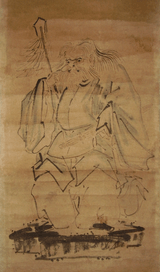Sarutahiko Okami
| Part of a series on |
| Shinto |
|---|
 |
| Practices and beliefs |
| Shinto shrines |
| Notable Kami |
| Important literature |
|
| See also |
|
|
Sarutahiko Ōkami (猿田毘古大神, 猿田彦大神), is the leader of the earthly kami, deity of the Japanese religion of Shinto. Norito also mentions him with the title Daimyōjin (大明神 great bright god, or greatly virtuous god) instead of Ōkami (大神 great god).
Sarutahiko Ōkami is seen as a symbol of Misogi, strength and guidance, which is why he is the patron of martial arts such as aikido.[1] He enshrined at Tsubaki Grand Shrine in Mie Prefecture, first among the 2000 shrines of Sarutahiko Ōkami, Sarutahiko Jinja in Ise, Mie and Ōasahiko Shrine in Tokushima Prefecture. In the Nihon Shoki, he is the one who greets Ninigi-no-Mikoto, the grandson of Amaterasu, the Sun goddess, when he descends from Takama-ga-hara.[2] He is depicted as a towering man with a large beard, jeweled spear, ruddy face, and long nose. At first he is unwilling to yield his realm until persuaded by Ame-no-Uzume-no-Mikoto, the kami of dance and the arts, whom he later marries.[3]
His Paredros and children created the Sarume no Kimi (猿女の君) clan along with an order of female court and religious dancers. It was the origin of Kagura and Nogaku. Other descendants includes the Ujitoko clan from Ise province. According to Kojiki, he went in Ise where a giant clam trapped his hand on Isuzu river at Azaka, thus he drowned. But strangely, Sarutahiko was considered by Ueshiba Morihei as a kind of god of the cosmic life : the god of Aiki. According to O-Senseï, the practice of Aikidō was practice of Misogi purification itself (and thus, like Sarutahiko standing of Ame-no-Ukibashi, standing between Heaven and Earth, being one with the Universe, and so achieving peace with the world, the next step being World Peace itself)... which doesn't fit very well this Kojiki story of Sarutahiko's death (although it is unknown if he really died from it).

Etymology
Sarutahiko's name consists of an etymologically obscure element, Saruta, which is traditionally transcribed with kanji that suggest the meaning "monkey-field" as a sort of double entendre, followed by the Classical Japanese noun hiko "a male child of noble blood, a prince."[4] Thus, Sarutahiko Ōkami's embellished name could be roughly translated into English as "Great God, Prince Saruta." Many variant pronunciations of his name exist, including Sarudabiko and Sadahiko. Although it is usually not written, the Japanese genitive case marker, -no, is often suffixed to his name in speech when it is followed immediately by one of his honorific titles, such as Ōkami or Mikoto.
Anthropologist Emiko Ohnuki-Tierney lists three factors that identify Sarutahiko as a monkey deity: saru means "monkey", his features "include red buttocks, which are a prominent characteristic of Japanese macaques", and as macaques gather shellfish at low tide, the Kojiki says his hand got caught in a shell while fishing and "a monkey with one hand caught in a shell is a frequent theme of Japanese folktales".[5]
Title
Sarutahiko has the distinction of being one of only seven kami to be honored with the title Ōkami (Japanese: 大神) or "Great Kami"; the other six are Izanagi, Izanami, Michikaeshi (also known as Yomido ni sayarimasu ōkami (?) who is the kami of the great rock used by Izanagi to obstruct the way to Yomi, and thus, preventing emergence of evil spirits from the Underworld), Sashikuni, Inari, and Amaterasu. Sarutahiko and Inari appear to be the only Okami from the kunitsukami, or earthly kami, the others being Amatsukami (heavenly deities). Although there is some other Daimyōjin and Daigongen, most of them appeared latter in the History of Japanese Religion, such as Hachiman (deification of Empress Jingu, Emperor Ojin and maybe Takeuchi no Sukune, as a successful head of state) or Hindu deities, the meaning of Daimyōjin appear to be a little different from Ōkami, the latter being obviously more ancient.
References in music
The name of this deity appears incorrectly spelled as "Sarundasico" in Puccini's opera Madama Butterfly.[6]
See also
References
- ↑ Gleason, William (1995). The Spiritual Foundations of Aikido. Destiny Books. p. 18. ISBN 0-89281-508-6.
- ↑ "English" (PDF). 尾張猿田彦神社. Retrieved 14 August 2012.
- ↑ "Shrine History". Tsubaki Grand Shrine America. Retrieved 13 August 2012.
- ↑ Ashkenazi, Michael (2003). Handbook of Japanese Mythology. ABC-CLIO. p. 70. ISBN 1-57607-467-6.
- ↑ Ohnuki-Tierney, Emiko (1987), The Monkey as Mirror: Symbolic Transformations in Japanese History and Ritual, Princeton University Press, pp. 42-43.
- ↑ "2004 Regular Opera Performance "Madama Butterfly / revised edition"". NPO Opera del Popolo. Retrieved 13 August 2012.